1993 CHEVROLET ASTRO PASSENGER manual transmission
[x] Cancel search: manual transmissionPage 57 of 345

Downloaded from www.Manualslib.com manuals search engine Features & Controls
ic
c
Here you can learn about the many standard and optional featur\
es on your
vehicle, and information on starting, shifting and braking. Also\
explained are
the instrument panel and the warning systems that tell you
if everything is
working properly-and what
to do if you have a problem.
For explanation of vehicle symbols, refer to “Vehicle Symbols in
Section
0.
Keys ........................................................................\
............................................... 2-3
Your Doors and How They Work
........................................................................\
2-5
Door
Locks ........................................................................\
.................................. 2-1 0
Theft ........................................................................\
............................................. 2-1 2
New Vehicle “Break-In”
........................................................................\
.............. 2-1 3
Ignition Switch ........................................................................\
............................. 2-1 3
Starting Your Engine ........................................................................\
................... 2-14
Fuel Regulator
........................................................................\
......................... 2-15
Driving Through Deep Standing Water
.......................................................... 2-16
Engine Block Heater
........................................................................\
............... 2-1 6
Automatic Transmission ........................................................................\
.............. 2-1 7
Locking Rear Axle ........................................................................\
....................... 2-20
Parking Brake
........................................................................\
.............................. 2-20
2-1
Page 68 of 345
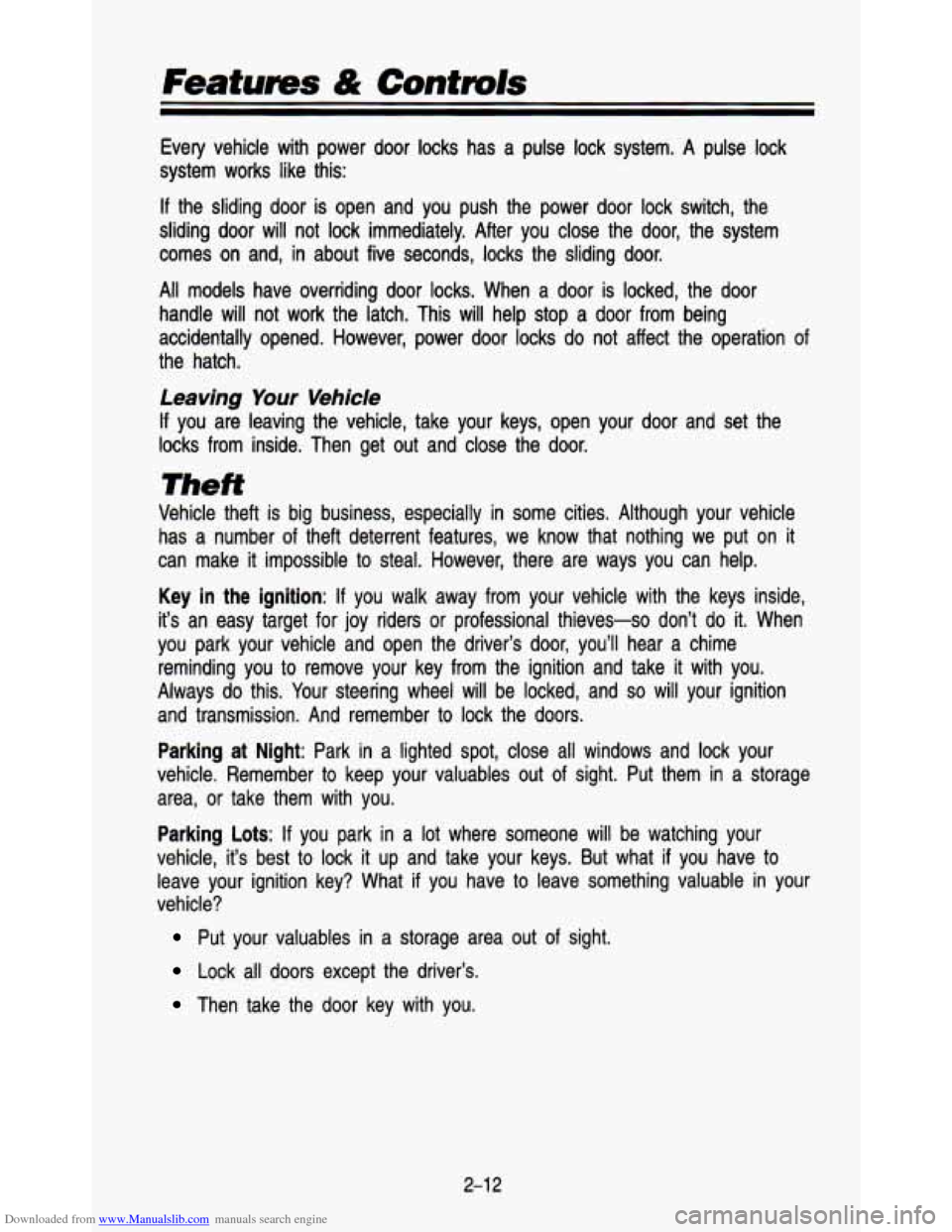
Downloaded from www.Manualslib.com manuals search engine Features & Contds
Every vehicle with power door locks has a pulse lock system. \
A pulse lock
system works like this:
If the sliding door is open and you push the power door lock sw\
itch, the
sliding door will not lock immediately. After you close the do\
or, the system
comes on and, in about five seconds, locks the sliding door.
All models have overriding door locks. When a door is locked, the \
door
handle will not work the latch. This will help stop a door from being
accidentally opened. However, power door locks do not affect th\
e operation of
the hatch.
Leaving Your Vehicle
If you are leaving the vehicle, take your keys, open your door and set t\
he
locks from inside. Then get out and close the door.
Theft
Vehicle theft is big business, especially in some cities. Although your vehicle
has a number of theft deterrent features, we know that nothing\
we put on it
can make
it impossible to steal. However, there are ways you can help.
Key in the ignition: If you walk away from your vehicle with the keys inside,
it’s an easy target for joy riders
or professional thieves-so don’t do it. When
you park your vehicle and open the driver’s door, you’ll \
hear a chime reminding you to remove your key from the ignition and take i\
t with you.
Always do this. Your steering wheel will be locked, and
so will your ignition
and transmission. And remember
to lock the doors.
Parking at Night: Park in a lighted spot, close all windows and lock your
vehicle. Remember to keep your valuables out of sight. Put the\
m in a storage
area,
or take them with you.
Parking Lots: If you park in a lot where someone will be watching your
vehicle,
it’s best to lock it up and take your keys. But what if you have to
leave your ignition key? What
if you have to leave something valuable in your
vehicle?
Put your valuables in a storage area out of sight.
Lock all doors except the driver’s.
Then take the door key with you.
2-1 2
Page 74 of 345
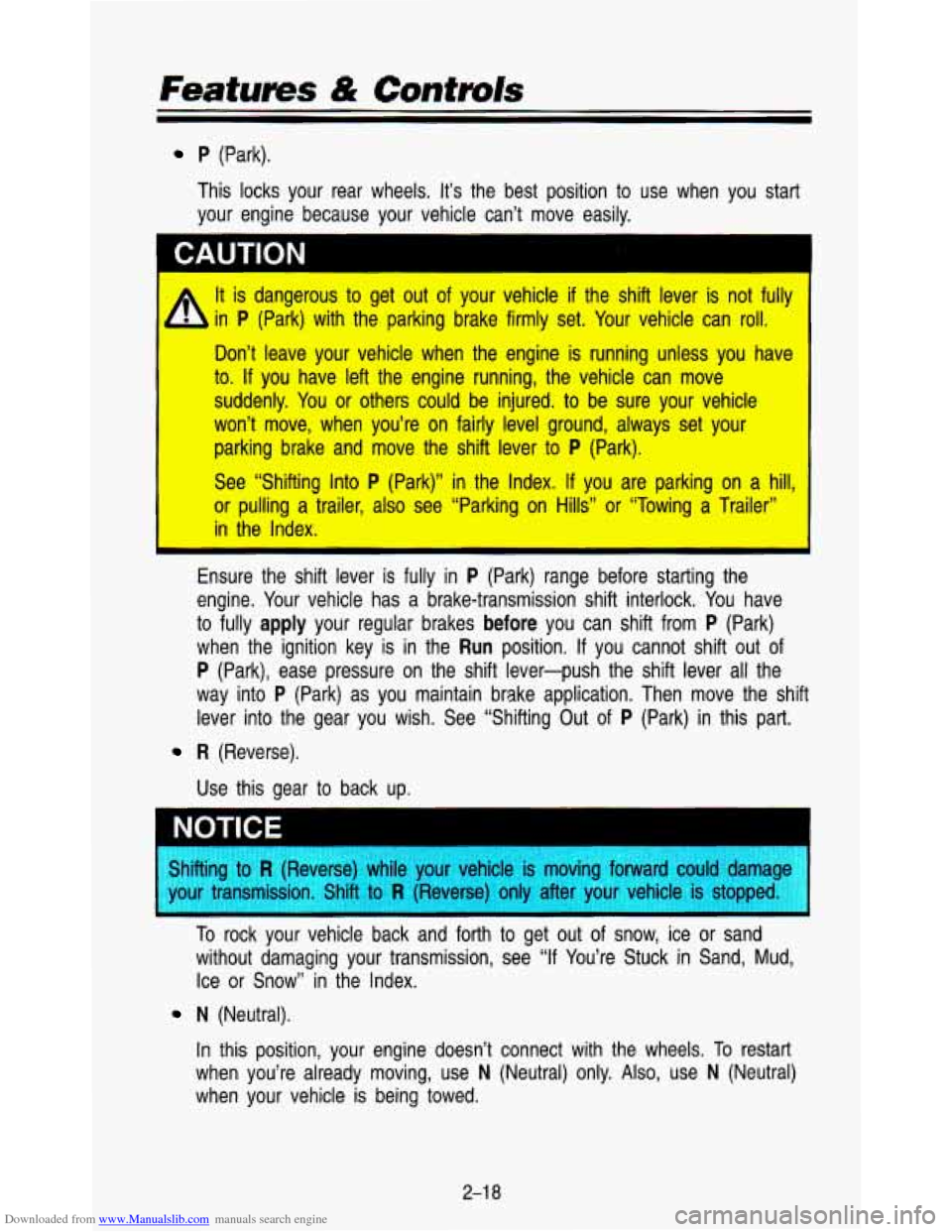
Downloaded from www.Manualslib.com manuals search engine P (Park).
This locks your rear wheels.
It’s the best position to use when you start
your engine because your vehicle can’t move easily.
WTION
It is dangerous to get out of your vehicle if the shift lever is not -fully
in
P (Park) with the parking brake firmly set. Your vehicle can roll. .
Don’t leave your vehicle when the engine is running unless you have
to.
If you have left the engine running, the vehicle can move
suddenly. You
or others could be injured. to be sure your vehicle
won’t move, when you’re on fairly level ground, always set your
parking brake and move the shift lever
to P (Park).
See “Shifting Into
P (Park)” in the Index. If you are parking on a hill:
or pulling a trailer, also see “Parking on Hills” or “Towing a Trailer”
in the Index.
Ensure the shift lever is fully in
P (Park) range before starting the
engine. Your vehicle has a brake-transmission shift interlock. You have
to fully
apply your regular brakes before you can shift from P (Park)
when the ignition key is in the
Run position. If you cannot shift out of
P (Park), ease pressure on the shift lever-push the shift lever\
all the
way into
P (Park) as you maintain brake application. Then move the shift\
lever into the gear you wish. See “Shifting Out of
P (Park) in this part.
R (Reverse).
Use this gear to back up.
I
Shifting to R (Reverse) while your vehicle is moving forward could dama--
your transmission. Shift
to R (Reverse) only after your vehicle is stoppec
To rock your vehicle back and forth to get out of snow, ice or sand
without damaging your transmission, see
“If You’re Stuck in Sand, Mud,
Ice or Snow” in the Index.
N (Neutral).
In this position, your engine doesn’t connect with the wheels.
To restart
when you’re already moving, use
N (Neutral) only. Also, use N (Neutral)
when your vehicle
is being towed.
2-1 8
Page 75 of 345
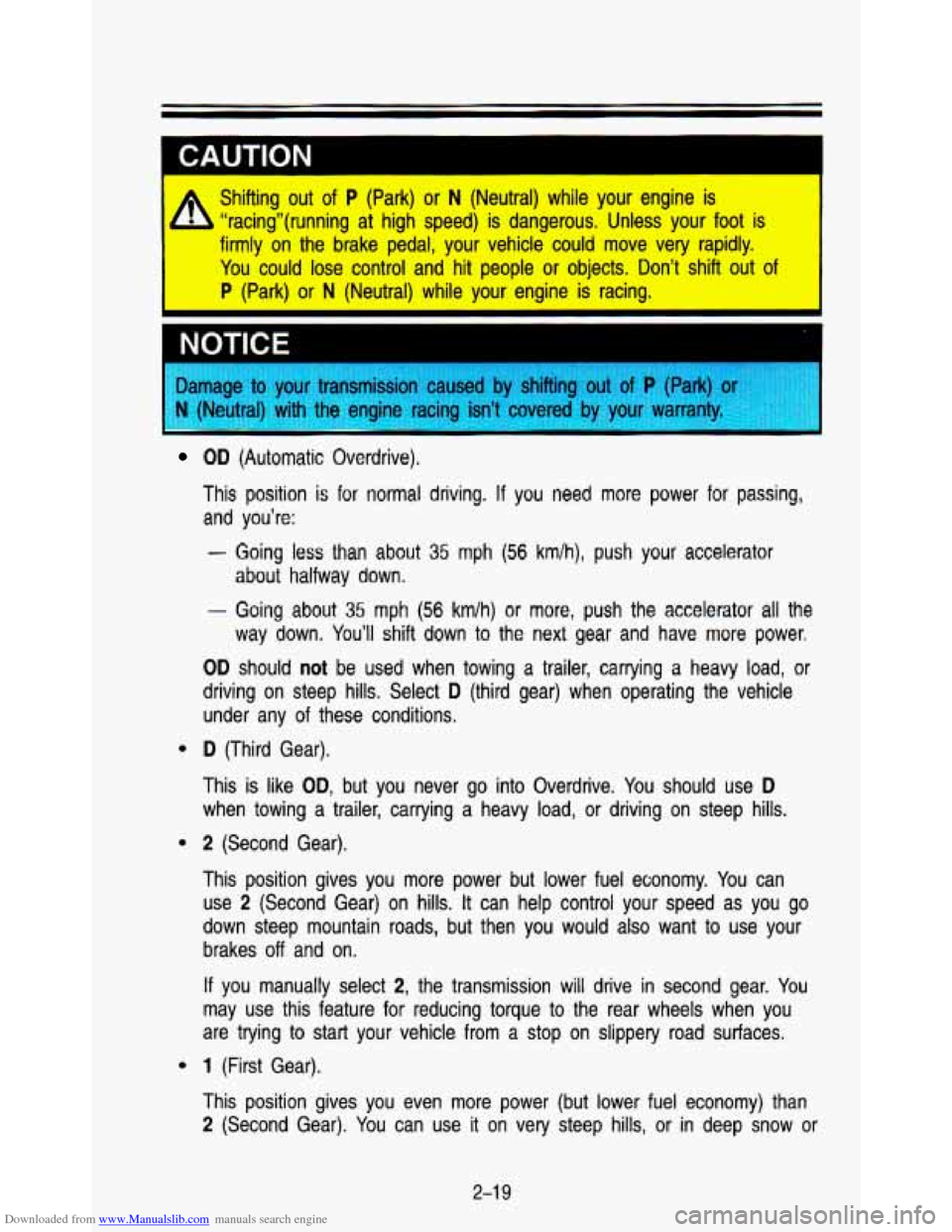
Downloaded from www.Manualslib.com manuals search engine CAUTION
Shifting out of P (Park) or N (Neutral) while your engine is
b “racing”(running at high speed) is dangerous. Unless your\
foot is
firmly on the brake pedal, your vehicle could move very rapidl\
y.
You could lose control and hit people or objects. Don’t shift out
of
P (Park) or N (Neutral) while your engine is racing.
NOTICE
sed by shifting out of P (Park) (
g isn’t covered I . .. . . . . . by . , . ..I. your , , , , warranty. , ., , ; s,L ., ... . , I . ::: :,.:. ’ .. ’., ; , : , .. . .: .. . , .. , , , . . . , .,
e
e
e
OD (Automatic Overdrive).
This position is for normal driving. If you need more power for passing,
and you’re:
- Going less than about 35 mph (56 km/h), push your accelerator
about halfway down,
- Going about 35 mph (56 km/h) or more, push the accelerator all the
way down. You’ll shift down to the next gear and have more power.
OD should not be used when towing a trailer, carrying a heavy load, or
driving on steep hills. Select
D (third gear) when operating the vehicle
under any of these conditions.
D (Third Gear).
This
is like OD, but you never go into Overdrive. You should use D
when towing a trailer, carrying a heavy load, or driving on steep hills.
2 (Second Gear).
This position gives you more power but lower fuel economy. You can
use
2 (Second Gear) on hills. It can help control your speed as you go
down steep mountain roads, but then you would also want to use your
brakes
off and on.
If you manually select 2, the transmission will drive in second gear. You
may use this feature
for reducing torque to the rear wheels when you
are trying to start your vehicle from
a stop on slippery road surfaces.
1 (First Gear).
This position gives you even more power (but lower fuel econo\
my) than
2 (Second Gear). You can use it on very steep hills, or in deep snow or
2-1 9
Page 76 of 345
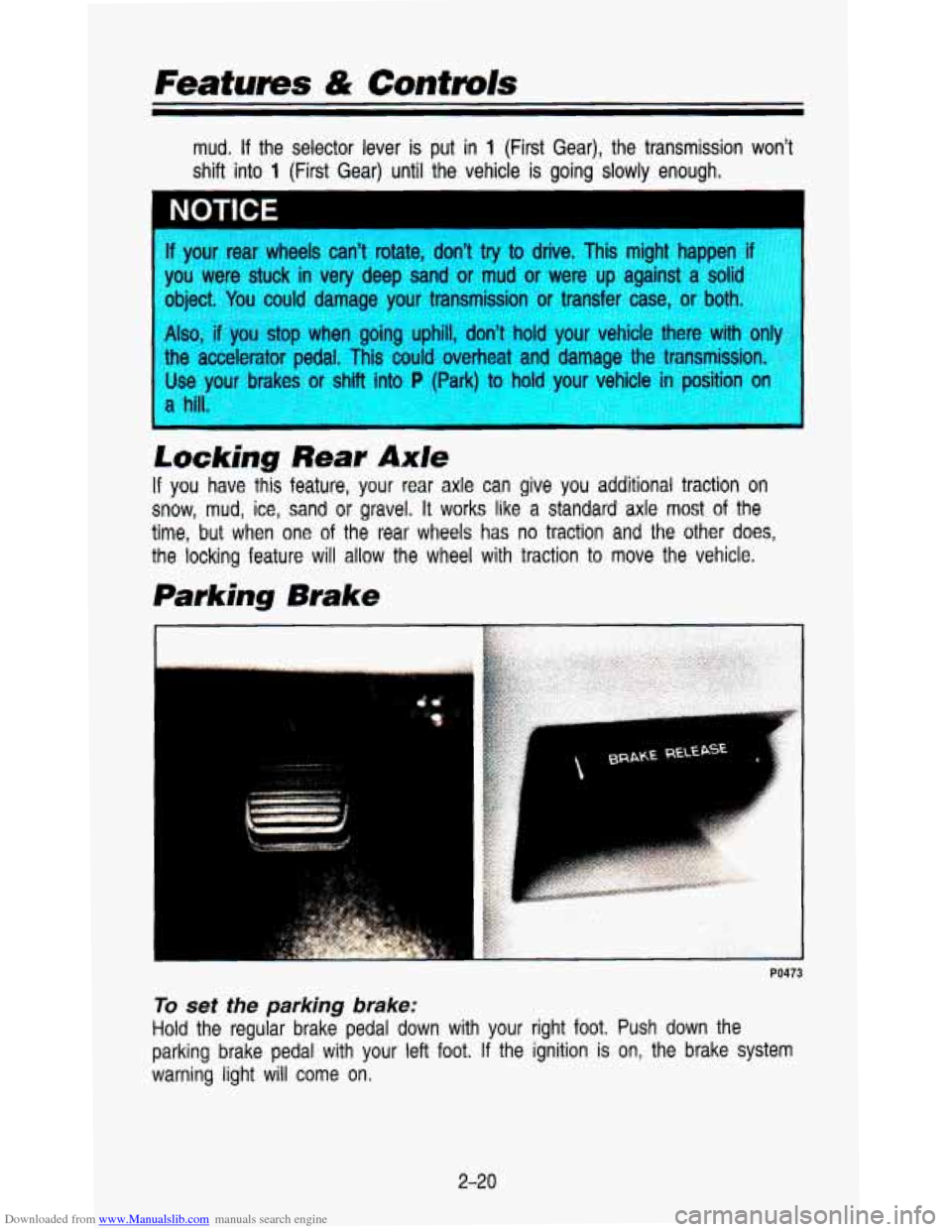
Downloaded from www.Manualslib.com manuals search engine Features & Controls
mud. If the selector lever is put in 1 (First Gear), the transmission won't
shift into
1 (First Gear) until the vehicle is going slowly enough.
NOTICE 1
I
If your rear wheels can't rotate, don't try to drive. This might happen
you were stuck in very deep sand
or mud or were up against a soli(
obiect. You could damage your transmission or transfar case, or hoth
Atso, IT u stop when goir uphill, m't hold your vel ~ -e tl 'e with only
the accelerator pedal. This could overheat and damage the transmission.
Use yo1 "--kes or shift into :Park) hold your vehicle in position o
Loc&hg Rear Axle
If you have this feature, your rear axle can give you additional traction on
snow, mud, ice, sand or gravel. It works like a standard axle most of the
time,
but when one of the rear wheels has no traction and the other does,
the locking feature will allow the wheel with traction to move\
the vehicle.
Parking Brake
2-20
Page 79 of 345
![CHEVROLET ASTRO PASSENGER 1993 1.G Owners Manual Downloaded from www.Manualslib.com manuals search engine Shifting Out of P (park]
Your vehicle has a brake-transmission shift interlock. You have to fully apply
your regular brake before you CHEVROLET ASTRO PASSENGER 1993 1.G Owners Manual Downloaded from www.Manualslib.com manuals search engine Shifting Out of P (park]
Your vehicle has a brake-transmission shift interlock. You have to fully apply
your regular brake before you](/manual-img/24/8011/w960_8011-78.png)
Downloaded from www.Manualslib.com manuals search engine Shifting Out of P (park]
Your vehicle has a brake-transmission shift interlock. You have to fully apply
your regular brake before you can shift from P (Park) when the ignition is in
the
RUN position. See “Automatic Transmission” in the Index.
If you cannot shift out of P (Park), ease pressure on the shift lever-push the
shift lever all the way into
P (Park) as you maintain brake application. Then
move the shift lever into the gear you wish.
If you ever hold the brake pedal down but still can’t shift out of P (Park), try
this:
1. Turn the key to “Off’.
2. Apply and hold the brake until the end of Step 4.
3. Shift to N (Neutral).
4. Start the vehicle and then shift to the drive gear you want.
5. Have the vehicle fixed as soon as you can.
Parking Over Things That Burn
-1
AN22001 2
CAUTION
Things that can burn could touch hot. exhaust parts under your
vehicle and ignite. Don’t park over papers, leaves,
dry grass or other‘
I
I things that- can burn. :-
2-23
Page 189 of 345
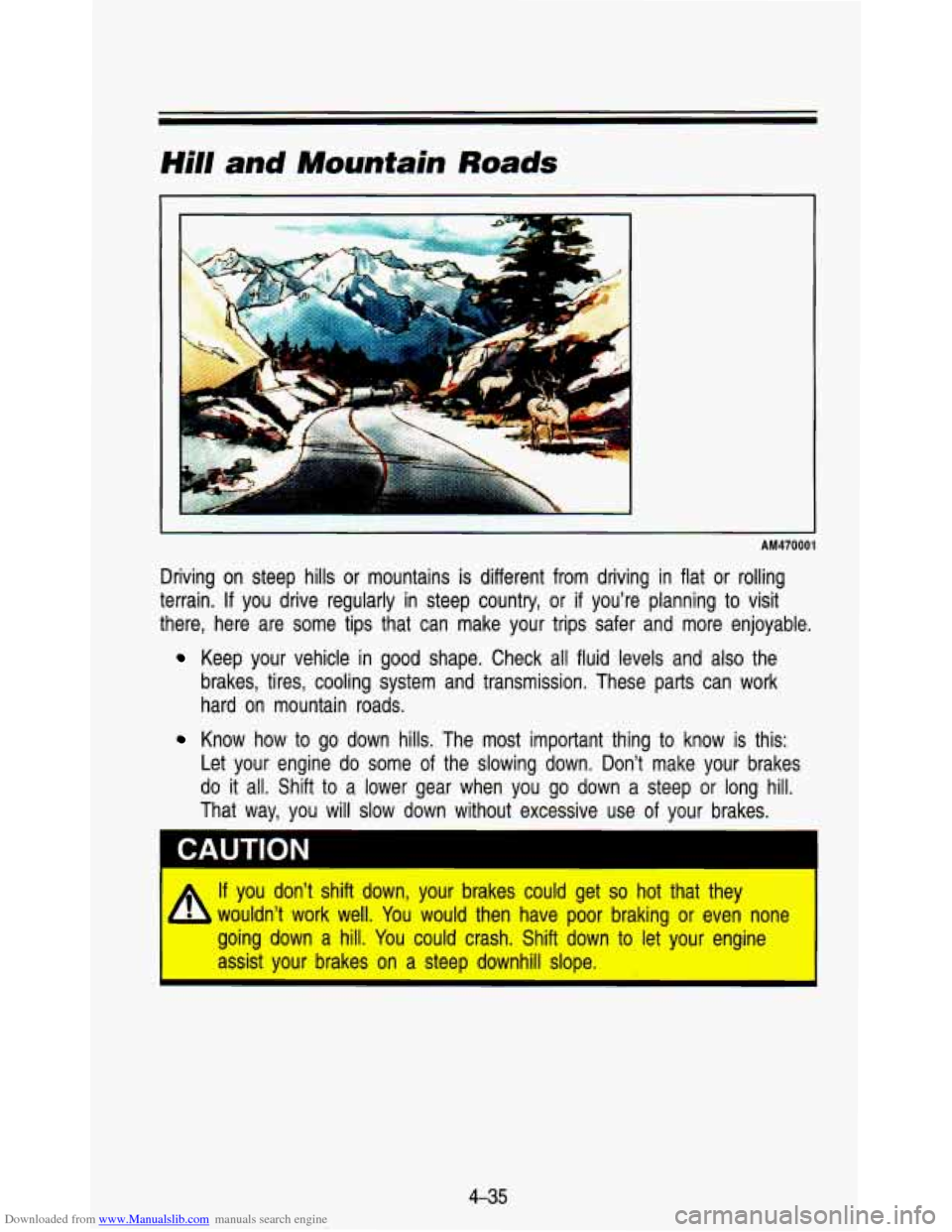
Downloaded from www.Manualslib.com manuals search engine Hill and Mountain Roads
AM470001
Driving on steep hills or mountains is different from driving in flat or rolling
terrain.
If you drive regularly in steep country, or if you're planning to visit
there, here are some tips that can make your trips safer and more enjoyab\
le.
Keep your vehicle in good shape. Check all fluid levels and also the
brakes, tires, cooling system and transmission. These parts can \
work
hard on mountain roads.
Know how to go down hills. The most important thing to know is this:
Let your engine
do some of the slowing down. Don't make your brakes
do it all. Shift
to a lower gear when you go down a steep or long hill.
That way, you will
slow down without excessive use of your brakes.
* If you don't shift down, your brakes could get so hot that they
L b wouldn't work well. You would then have poor braking or even none
going down a hill. You could crash. Shift down to let your engine
assist your brakes on a steep downhill slope.
4-35
Page 190 of 345
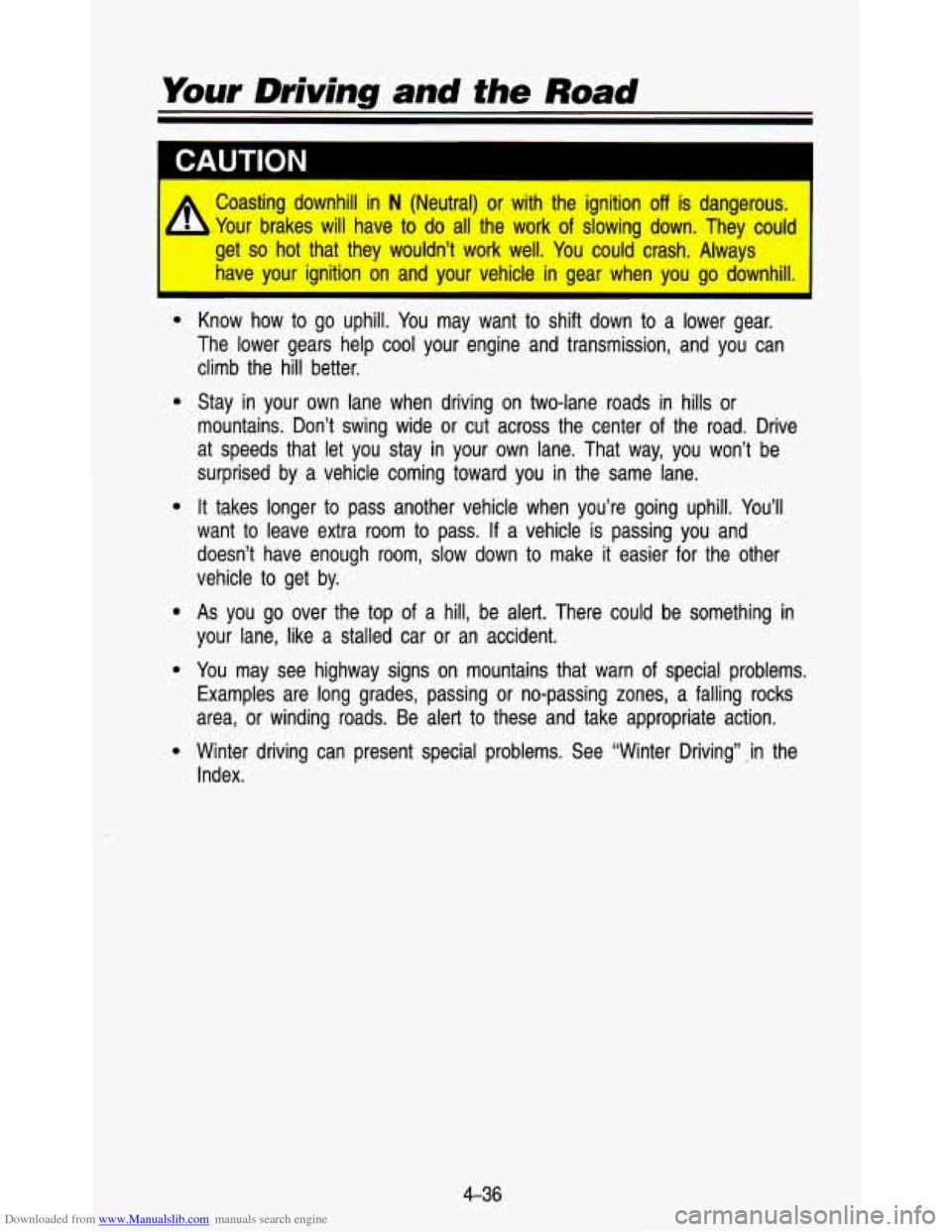
Downloaded from www.Manualslib.com manuals search engine Your Driving and the Road
I
CAUTION 1
A
Coasting downhill in N (Neutral) or with the ignition off is dangerous.
Your brakes
will have to do all the work of slowing down. They could
get
so hot that they wouldn’t work well. You could crash. Always
have vour ignition on and vour vehicle in aear when you go downhill.
--
Know how to go uphill. You may want to shift down to a lower gear.
The lower gears help cool your engine and transmission, and you can
climb the hill better.
Stay in your own lane when driving on two-lane roads in hills or
mountains. Don’t swing wide or cut across the center of the\
road. Drive
at speeds that let you stay in your own lane. That way, you won’t be
surprised by a vehicle coming toward you in the same lane.
It takes longer to pass another vehicle when you’re going uphill. You’ll
want to leave extra room to pass.
If a vehicle is passing you and
doesn’t have enough room, slow down to make it easier for the other
vehicle to get by.
As you go over the top of a hill, be alert. There could be something in
your lane, like a stalled car or an accident.
You may see highway signs on mountains that warn
of special problems.
Examples are long grades, passing or no-passing zones, a fallin\
g rocks
area, or winding roads. Be alert
to these and take appropriate action.
Winter driving can present special problems. See “Winter Driv\
ing” ,,in the
Index.
4-36